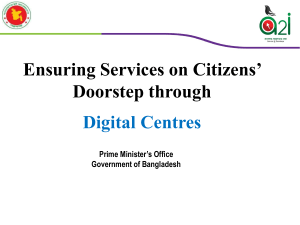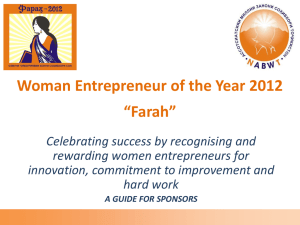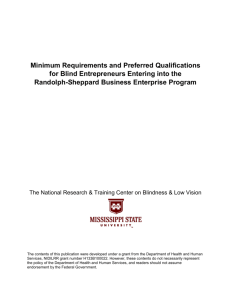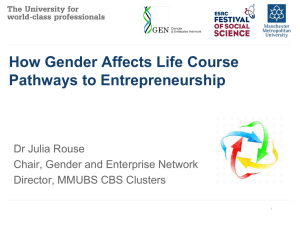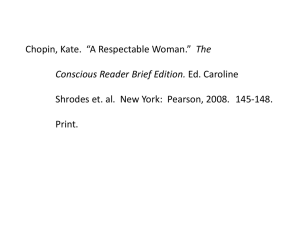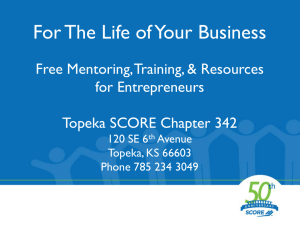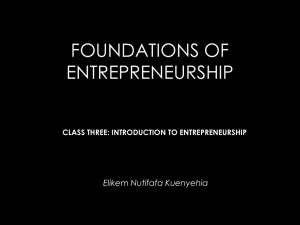Handout
advertisement
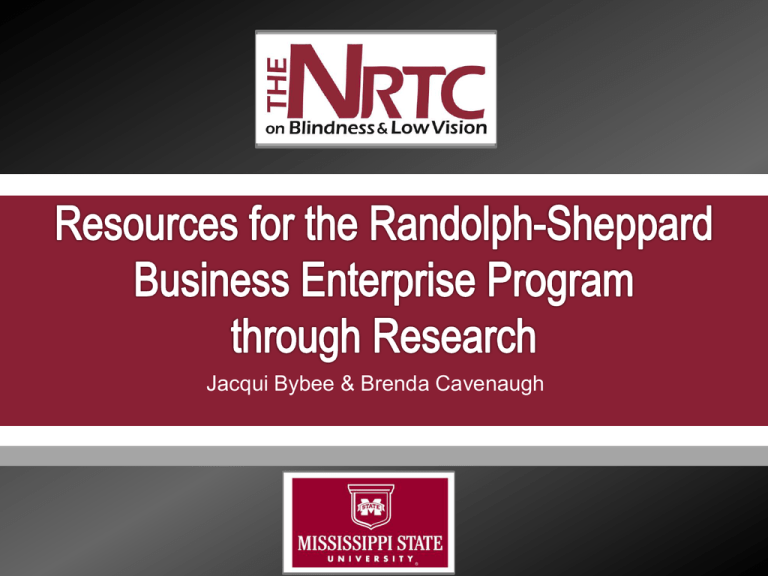
Jacqui Bybee & Brenda Cavenaugh Randolph-Sheppard Business Enterprise Program • Priority to operate food service facilities on federal properties • “For the purposes of providing blind persons with remunerative employment, enlarging the economic opportunities of the blind, and stimulating the blind to greater efforts in striving to make themselves self-supporting” 2 Significant changes since its enactment in 1936 Mini R-S Act Private sector Types of facilities Sub-contracting Franchising Average earnings in 2010 - $56,168 3 Steady decline in the number of blind entrepreneurs and facilities • 1994 – 3,524 blind entrepreneurs and 3,419 facilities • 2001 – 2,711 blind entrepreneurs and 3,194 and facilities • 2010 – 2,319 blind entrepreneurs and 2,514 and facilities 4 Growing opportunities outside R-S Skills needed Carryover perceptions Disparities within states in number of blind entrepreneurs and available facilities • Inability to cross state lines 5 Increase the number of blind entrepreneurs Increase the number of facilities in all sectors Market Build the program national brand recognition Enable alignment of resources and talent Develop resources and materials based on data collected from BEP professionals and blind entrepreneurs in order to enhance and grow the program • Marketing materials • Resource guides • Publications • Training materials • Reference materials 7 75 closed and open-ended responses 44 respondents – state BEP directors or their designees Broad scope covering recruitment, training, accommodations, standards, program requirements, etc. Used for several components of project 8 Goal: Identify training needs for new BEP staff and develop updated training in response 50+ training area needs assessed Closed and open-ended response questions 44 state directors or their designees participated 9 Moore, E.J. (1999). Making the Randolph-Sheppard Program More Competitive: Results of a National Training Needs Assessment. RE:view. 31(2), 67-75. • Surveyed 97 BEP business counselors about the most important training topics for BEP staff • Basic marketing and sales promotion • Blind entrepreneur training and readiness for employment • Human relation skills • Surveyed 99 BEP blind entrepreneurs about most important skills for BEP staff • Business management skills • Knowledge of food service • Knowledge of customer service 10 Mean Importance Scores of Training Needs Determined by BEP Staff n M Marketing and customer service 41 6.27 Communication skills 42 6.07 Negotiation skills 43 5.88 Accounting and Taxation 41 5.85 Supervisory skills 42 5.81 Training skills 43 5.74 Knowledge of using AT in business settings 44 5.55 Healthy food options 42 5.55 Food service 41 5.49 New vending 41 5.32 Maintenance/repair skills for maintaining equipment 40 5.27 Security 41 5.24 Partnering/franchising opportunities 40 5.08 Knowledge of R-S Act 43 5.07 Knowledge of low vision technologies 43 5.00 Rehabilitation and blindness 43 4.98 The VR process 44 4.64 11 Each state develops its own training curriculum and content One national curriculum • Minton, E.A., Spann, V.J. & Weston, E.A. (1985). Randolph- Sheppard Management System. West Virginia Research and Training Center, West Virginia Division of Vocational Rehabilitation. Few states use this training curriculum • Outdated 12 National Online Training Curriculum for BEP Staff 14 modules • Modules based on research results • Self-paced • Free • Supplement other training activities 13 Orientation to Blindness Vocational Rehabilitation and How it Intersects with Randolph-Sheppard The Randolph-Sheppard Act and Its Implementing Regulations Active Participation – What It Is and What It Isn’t Assistive Technology and Its Potential for Blind Entrepreneurs The Role of the Business Consultant Business Principles of Managing a Food Service Facility 14 Human Resource Management for the RandolphSheppard Blind Entrepreneur Marketing and Customer Service Relations Marketing the Randolph-Sheppard Program to Outside Parties Teaming and Branding – A Way to Increase Income for Blind Entrepreneurs Food Safety and Sanitation Changing Trends: Meeting the Challenges of Providing Healthy Food Options Maximizing Opportunities for Blind Entrepreneurs with a Hearing Loss 15 Bybee, J. & Cavenaugh, B.S. (2014). RandolphSheppard National Online Training Curriculum for Program Staff: Findings from a National Survey of Randolph-Sheppard Directors. Journal of Visual Impairment & Blindness. 108(2), 157-162. Second publication on training needs of blind entrepreneurs 16 Standardizes knowledge across the entire program Ensures comprehensiveness of training Allows for easier transition from one state program to another May increase knowledge in key areas to help enhance the program 17 Individuals with dual sensory loss are at greater risk for low employment outcomes How can an individual with a dual sensory loss run a food service facility? 18 Jordan, B. (2008). The Success of Blind Vendors who also have Hearing Loss. Helen Keller National Center. Shawnee Mission, KS. • Surveyed 29 blind entrepreneurs with hearing loss • Blind entrepreneurs with hearing loss excel in the Randolph-Sheppard Program 19 Goal: Gain knowledge of working with blind entrepreneurs with hearing loss through the perspective of BEP professionals Contacted 29 state BEP directors that have experience in working with blind entrepreneurs with hearing loss • Ask permission to contact other experienced BEP staff and blind entrepreneurs with hearing loss Conducted in-depth interviews 20 43 participants from 14 states • 16 (37%) BEP directors • 5 (13%) Training staff • 11 (25%) BEP counselors • 11 (25%) Entrepreneurs with hearing loss 21 BEP staff confirmed that blind entrepreneurs with hearing loss excel in the R-S program • No staff member felt that hearing loss was a barrier to success • Accommodations and communication strategies available to meet any situation 22 “BEP staff members felt that training and working with blind entrepreneurs with hearing loss did present some unique situations for accommodation. However, an effective solution was always found, and once found, it was no different than working with any other entrepreneur in the BEP.” “Entrepreneurs with a vision and hearing loss said that the most challenging aspect or their job is conducting daily business operations including the balancing act of maintaining proper inventory levels, keeping employees happy, and delivering excellent customer service – the same issues that any entrepreneur encounters when running a business.” 23 Working with Blind Entrepreneurs who have a Hearing Loss in the Randolph-Sheppard Business Enterprise Program Resource Guide • Introduction to hearing loss and common accommodations used • Working with blind entrepreneurs with a hearing loss in training, on-the-job, and at state/national meetings • Advice and experiences of BEP staff and blind entrepreneurs • Suggestions for program improvement • Resource list for accommodating Available for free download at: http://blind.msstate.edu/our-products/resource-guide/ • Under “Our Products” tab 24 Average age is around 50 years old Why is this? • Younger individuals have increased opportunities outside the R-S program • Misinformed about the program Any other ideas? 25 “Aging-out” of blind entrepreneurs 17 states identified as having recruitment practices for transition-age • Job shadowing opportunities • Summer programs • Relationships with local schools 26 Conduct in-depth interviews • Ask about recruitment practices • Summer programs • Activity at consumer groups • Other opportunities for transition-age individuals guide will be developed on “best practices” for recruiting transition-age individuals into the BEP Marketing brochure will be developed targeted for transition-age individuals Resource 27 Each state has different entry-level requirements • High school diploma or GED • 18 years of age • Minimum mathematical and English proficiencies No standardized list of preferred qualities 28 Compile minimum entry requirements for each state BEP • Useful tool to have all states’ requirements combined in one document Identify and compile a list of preferred qualifications for BEP entrepreneurs entering the program • Useful tool to have a “master” list of recognized skills necessary to be successful in the BEP 29 Compile baseline • Net profit • Gross sales • Operating costs facility performance data • Computed based on figures from several states across the country • Listed by type of facility and area profile • Useful as a supplemental resource for assessing the viability of a current or future BEP facilities 30 31 Available for free download at our website: http://blind.msstate.edu/ • “Our Products” tab Marketing tool Template for state-specific design 32 Questions? Comments? Suggestions? Points of interest? 33 Jacqui Bybee • 662-325-7824 • jbybee@colled.misstate.edu Project website • http://blind.msstate.edu/research/projects/ project.php?id=4 34
